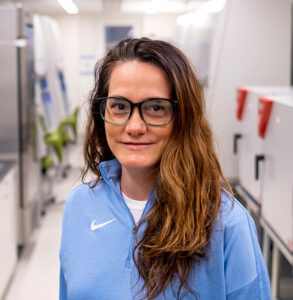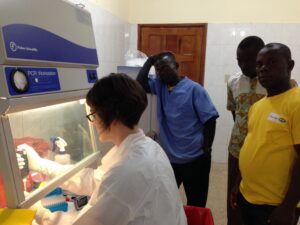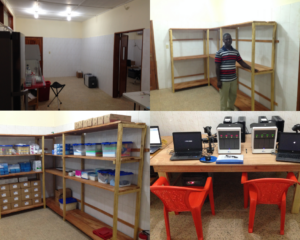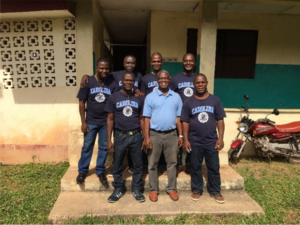In November 2020, Amy James Loftis was hyper-focused on keeping the Carolina community safe, building UNC’s COVID Surveillance Lab in three short months before the return of students. But there were many years leading up to that moment. Often described as the Institute’s secret weapon in the fight against global health disease, Amy travels around the world, building infrastructures for research excellence, and she has received a number of awards for research excellence and service. Once, she was “adopted” by a Liberian tribe and named ‘Nenikolay,’ which loosely translates to indigenous scientist or medical doctor.

How did you get started in global health research?
“When I came to Carolina in 2000, I joined what at the time was called the Retrovirology Lab, working with Susan Fiscus, who came out of retirement during COVID to help build the COVID Surveillance Lab. My first project was a breast milk study with the late Charlie van der Horst, and I was incredibly interested in learning the treatments for the moms and how they impact the babies. Then there was the launch of the state HIV testing program, and I worked with the team here to implement a testing mechanism for babies born to women with HIV. All of these were very interesting lab projects that got me interested in research.
“During this time, Mike Cohen was working with a team in China. A small cohort came to UNC, and we taught them what we were doing for the state lab, HIV incidence testing. This gave me the opportunity for my first international trip, going to Nanjing to set up pooling testing for five clinics. We taught the team there how to do the testing, and this was the first transfer of knowledge and technology to the Chinese team. They found that the incidence of just those five clinics was the same as the entire state of North Carolina. And from there, they started having HIV testing, and then National HIV Testing Day and then World AIDS Day.

“Then, I switched to the CFAR lab to do sequencing and I found that very interesting, drug resistance testing for HIV, trying to understand the drug switch. It was fascinating to work with technologies that show exactly what’s happening in the body. We can see when a drug doesn’t work based on the gene sequence. And then Susan Fiscus, took on the directorship of what is now the International Maternal Pediatric Adolescent AIDS Clinical Trials (IMPAACT) Network, and I started working on what would become one of the largest clinical trials known as PROMISE Study. This was a randomized controlled trial conducted in 14 countries around the globe that began in 2010. The aim was to determine the optimal antiretroviral strategy to prevent vertical transmission of HIV and maintain maternal and infant health.”
What would you say was the turning point in your career?
Through the IMPAACT Network, I started international work, helping laboratories implement this study and keep quality measures in place. I also took a position in the IMPAACT Lab Center, Susan was the direct PI, and I was able to stay at UNC doing some wet lab work while also helping our international colleagues. I was putting most of my efforts into the PROMISE study, helping labs address global challenges and find clever ways to help them to do the work. This included the UNC site in Malawi as well as the Zambia site.

How did you start working with Ebola?
In 2014, I was in Cape Town, South Africa, attending a meeting with the African Society of Laboratory Medicine. Peter Piot, credited for discovering Ebola in Zaire in 1976, was giving a talk. Many of our colleagues couldn’t come to the meeting so I reached out to ask if anyone needed help. That’s when David Wohl and Billy Fisher said, we need your help, and that’s how I got involved with Ebola, not because I was an expert on Ebola, but because I was becoming a lab expert who understood viruses and lab quality and infection prevention.
During that time, David and Billy were working in Liberia, basically keeping people alive and following them longitudinally. This was a unique opportunity to study this horrible disease because generally people with Ebola don’t survive. I knew from our HIV work that viruses hide in immune priviledged places and transmission is likely to happen through those fluids. I borrowed space from Ron Swanstrom in the CFAR Lab in Lineberger to set up a small non-infectious Ebola lab, and I started doing some tests. I put inactive Ebola virus into semen and cervical samples to see if I would be able to detect it through an assay, and I did.

The Liberia team has called you the “Indiana Jones” of research. Can you describe your work there?
“I worked in Liberia for two years, living there for two and half months, to build the capacity needed to do testing. Much of this time was spent in rural Bong County, in a town called Bongba. This is where I converted an old eye clinic to a bio containment lab. I had to find someone to build shelves and tables because there was no place for instrumentation, which should be off the floor away from rodents and pests. I had to find unususal, meaning non-lab, ways to control heat and humidity. Things like black-out curtains came in handy for blocking the sun, which in turn kept the temperature in the lab within acceptable range. We didn’t have air conditioning in every room, and we didn’t always have petrol to run the generators. I was constantly challenged to find ways to maintain normal operations, running water, electricity, things that we don’t think about not having in other parts of the world.

“I stayed throughout the validation study because you have to do it over days and weeks of time before enrolling participants and assessing specimens. And as Billy said, we found that it does exist for quite a bit longer than we thought, as far as clearing the primary blood infection, or RNA detection. It was fascinating. We published the validation study, as well as our long-term survival study, for the participants.
“But while there, we realized there was a need for diagnostics for other things like malaria, TB, and yellow fever, other illnesses that couldn’t be properly diagnosed. In the end, we built a diagnostic lab that was able to do more than Ebola, and that allowed Billy and David to move on to study Lassa Fever. One of the things I’m most proud of is how we’ve advanced Liberia’s diagnostic laboratory abilities and the fact that what we constructed continues to help them in other ways.
“The craziest part was designing and building it. I’m not an architect and this was one of the hardest things to do starting with a sketch on a piece of paper and finding materials needed to be able to operate safely in the lab. And that was very arduous, yet proved to be another one of our biggest achievements.”

Then COVID-19 hit, and a clinical study coordinator said: ‘Just put on your PPE. Amy didn’t get Ebola, so let’s just do what she says.’ Tell us about that transition to COVID-19.
“Just as things were winding down in Liberia for me, I became for the first time in my career, hyper focused in Chapel Hill. I was working in the tent in the parking lot and still supporting our labs. But then I became solely focused on establishing a surveillance lab for testing. And this story is well documented.”
What are you working on now?
“At the moment, mostly in Malawi and Vietnam, and with our two clinical research sites in North Carolina (Chapel Hill and Greensboro). Vietnam is growing and now has another clinical research site, with six more labs. Altogether I have 10 labs that I monitor in Vietnam, where we’re still doing TB, HIV, and Hepatitis clinical trials. My primary focus is making sure we have all the labs producing high quality results for clinical trials, ensuring that we’re meeting Vietnam’s international standards as well as the U.S. guidelines for clinical trials. Recently, I’ve been supporting Vietnam’s National TB Reference Lab to participate in our NIH-sponsored clinical trials.”
As you support different labs around the world, how do you navigate language differences?
“I really try to learn when I’m traveling. In college, I took French, Spanish and Latin, which is an incredibly helpful tool, particularly if you’re doing medicine and research. I can read SOPs that are in different languages because of Latin words. In China, when I was there for a month for the first time, we made a pact to speak English in the morning and Chinese in the afternoons. Most of my Chinese is technical speak, but I still know some pleasantries. Right now, I’m using Duolingo to work on my Vietnamese.”
Tell us about some of the unique experiences you’ve had in your lab work?

In Liberia, we had a cobra get into the lab that we had to remove. We also had some excitement when a fire broke out. This story is actually pretty funny because it was on International Women’s Day and someone from the U.S. Department of Defense was visiting. She panicked and ended up leaving the building screaming. Meanwhile, I knew what to do. I put the fire out and made sure everyone was safe. Later, she said about her impulse to leave right away: ‘I think I just sent women back decades.’ Now, she always texts me on International Women’s Day to say ‘thanks for putting out that fire.’ After that day I also instituted a fire safety policy in Liberia because no fire truck would be coming to help should this happen again. Another teaching moment that actually can save lives.
How would you describe yourself?
“I would say I am an ordinary girl with an extraordinary job who has had the opportunity to contribute. Sometimes I’m not even aware that that contribution continues on. When I was doing a site visit in Uganda once, I saw they were still using an SOP I wrote. Meanwhile, our Zambia team refuses to change the SOP author name to someone else. They say: ‘No, you wrote it. Your name should be on it.’
“Most of the time my brain defaults to analytical thinking, and a creative solution spurs from an analytical observation. My brain doesn’t operate creatively by default, but if it did, I might have a better fashion sense. So I’m incredibly scientific, and when the light bulb comes on, it comes on bright.
“I’ve been told that I was born without a self-preservation gene. I’m one of those people who is going to take care of everyone else, and then I’ll get to me. That’s not necessarily a good model, but it’s who I am.”
The Institute for Global Health & Infectious Diseases (IGHID) attracts people who are driven to make big change. From principal investigators and grant managers to regulatory specialists and study coordinators, everyone has an important role to play in what we do around the world. We are pleased to highlight the work of the people who proudly serve IGHID.
